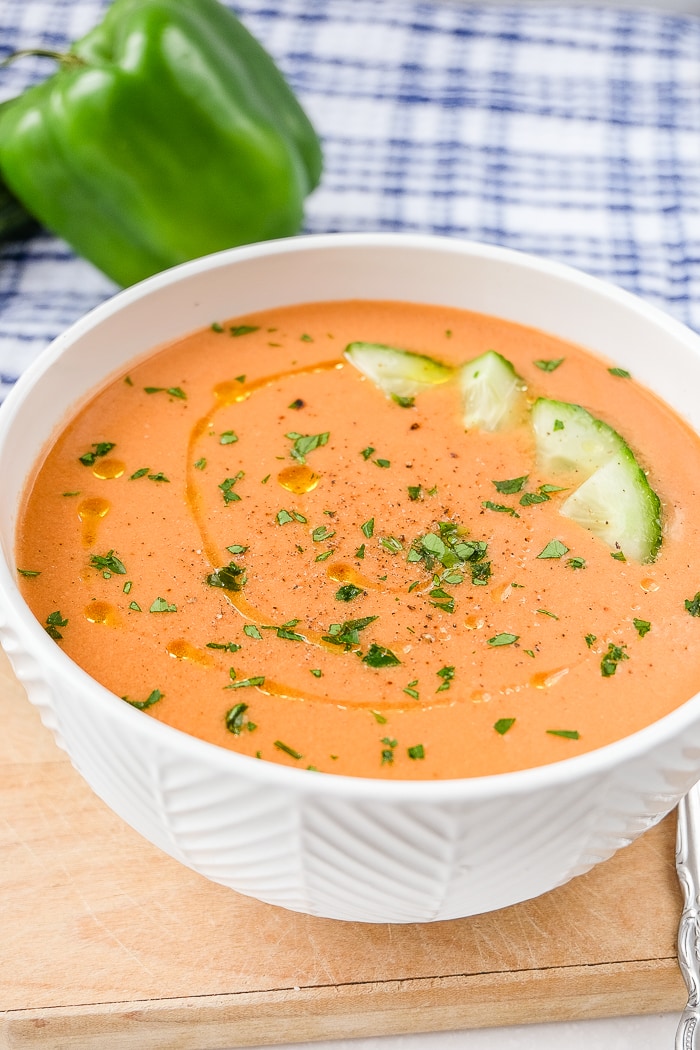Gazpacho, a cold soup originating from the southern regions of Spain, is a staple dish in Spanish cuisine. Its refreshing and flavorful blend of raw vegetables, olive oil, vinegar, and seasonings has made it a beloved summer delicacy, not only in Spain but also around the world.
Etymology and History
The term “gazpacho” is believed to have originated from the Latin word “caccabus,” meaning “cauldron.” This suggests that gazpacho has been enjoyed since ancient times, with its roots possibly traced back to Roman cuisine.
Ingredients and Preparation
Traditional gazpacho is crafted with a combination of stale bread, ripe tomatoes, cucumbers, green peppers, garlic, olive oil, wine vinegar, water, and salt. The vegetables are blended until smooth, creating a chilled and flavorful soup.
Variations
Gazpacho has evolved over the centuries, giving rise to numerous regional variations. Some popular variations include:
- Salmorejo: A thicker, creamier version of gazpacho, originating from Córdoba, Spain.
- Ajoblanco: A white gazpacho made with almonds and grapes, popular in the southern region of Andalusia.
- Pipirrana: A cold salad made with chopped tomatoes, cucumbers, onions, and peppers, similar to gazpacho but without the bread.
- Porra Antequerana: A thick, bread-based gazpacho from the town of Antequera in Andalusia.
Health Benefits
Gazpacho is not only delicious but also packed with nutrients. It is an excellent source of vitamins, minerals, and antioxidants, making it a healthy and refreshing choice.
Serving and Garnishes
Gazpacho is typically served chilled, often garnished with chopped vegetables such as cucumbers, tomatoes, onions, and peppers. Hard-boiled eggs, croutons, and slices of Serrano ham are also common accompaniments.
Gazpacho is a culinary masterpiece that embodies the flavors and traditions of Spanish cuisine. Its versatility, health benefits, and refreshing taste have made it a beloved dish enjoyed by people of all ages. Whether savored as a light lunch, a refreshing appetizer, or a healthy snack, gazpacho continues to captivate taste buds and bring a touch of Spanish sunshine to tables worldwide.
Recipe Tips & Substitutions
Here are some suggestions and replacements for this gazpacho soup before you cook it:
- Since we learned this recipe in Spain, we make it with a slice of stale white bread soaked in water. It gives the soup a little bit more body and thickens it. If you don’t like bread, though, by all means omit it; however, you should also refrain from adding the two tablespoons of water to the soup.
- It will be simpler to blend the soup if the vegetables are cut into small pieces, but don’t worry about cutting everything exactly. Just chop it up.
- It is crucial to strain or scrape the soup through a sieve fitted with tiny holes once you have blended it. In this manner, you can catch any remaining skins or seeds and have a smooth soup.

Gazpacho (Cold Spanish soup)
FAQ
Is gazpacho meant to be served cold?
Is gazpacho considered a soup?
What is the meaning of gazpacho?
What is so special about gazpacho?
Is gazpacho a specialty soup?
specialty soups. – Soups from a specific region, season, or culture. – A third category of soups, beyond clear and thick, that is something of a catch-all, also referred to as national soups or potage paysanne (soup of the people), a category that would include minestrone, gazpacho, avgolemono (Greek lemon and rice soup), vegetable tangine, Moroccan vegetable stew, French onion soup, corn and potato chowder, chili, borscht, and Brunswick Stew.
Do you eat gazpacho hot or cold?
This dish is also best served cold and popular during hot summers in Spain and Portugal. If you’re wondering what to eat with gazpacho, then keep an eye on these eleven appetizing side dishes and transform your ordinary gazpacho into an unforgettable meal.
Is gazpacho served hot or cold?
Gazpacho is served cold as a reflection of the hot region it originated from. The coolness of the soup is designed to cool you down on a hot Spanish day. Gazpacho can be served warm, but it is definitely made to be served cool. For more Spanish recipe, try out these classic dishes and drinks:
